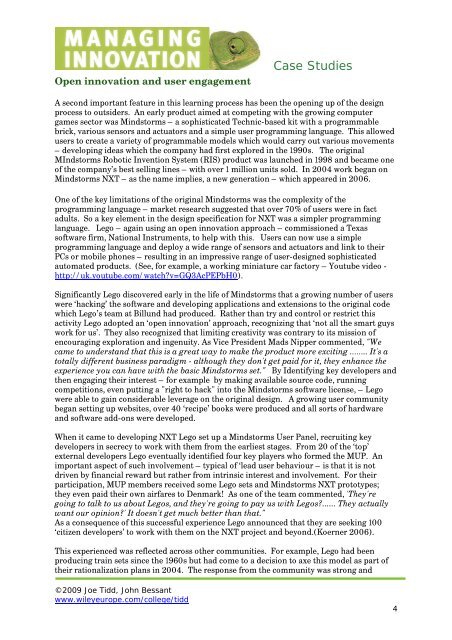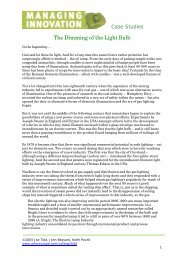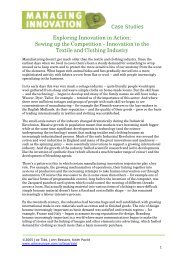Case Studies Lego - Managing Innovation
Case Studies Lego - Managing Innovation
Case Studies Lego - Managing Innovation
Create successful ePaper yourself
Turn your PDF publications into a flip-book with our unique Google optimized e-Paper software.
Open innovation and user engagement<br />
©2009 Joe Tidd, John Bessant<br />
www.wileyeurope.com/college/tidd<br />
<strong>Case</strong> <strong>Studies</strong><br />
A second important feature in this learning process has been the opening up of the design<br />
process to outsiders. An early product aimed at competing with the growing computer<br />
games sector was Mindstorms – a sophisticated Technic-based kit with a programmable<br />
brick, various sensors and actuators and a simple user programming language. This allowed<br />
users to create a variety of programmable models which would carry out various movements<br />
– developing ideas which the company had first explored in the 1990s. The original<br />
MIndstorms Robotic Invention System (RIS) product was launched in 1998 and became one<br />
of the company’s best selling lines – with over 1 million units sold. In 2004 work began on<br />
Mindstorms NXT – as the name implies, a new generation – which appeared in 2006.<br />
One of the key limitations of the original Mindstorms was the complexity of the<br />
programming language – market research suggested that over 70% of users were in fact<br />
adults. So a key element in the design specification for NXT was a simpler programming<br />
language. <strong>Lego</strong> – again using an open innovation approach – commissioned a Texas<br />
software firm, National Instruments, to help with this. Users can now use a simple<br />
programming language and deploy a wide range of sensors and actuators and link to their<br />
PCs or mobile phones – resulting in an impressive range of user-designed sophisticated<br />
automated products. (See, for example, a working miniature car factory – Youtube video -<br />
http://uk.youtube.com/watch?v=GQ3AcPEPbH0).<br />
Significantly <strong>Lego</strong> discovered early in the life of Mindstorms that a growing number of users<br />
were ‘hacking’ the software and developing applications and extensions to the original code<br />
which <strong>Lego</strong>’s team at Billund had produced. Rather than try and control or restrict this<br />
activity <strong>Lego</strong> adopted an ‘open innovation’ approach, recognizing that ‘not all the smart guys<br />
work for us’. They also recognized that limiting creativity was contrary to its mission of<br />
encouraging exploration and ingenuity. As Vice President Mads Nipper commented, "We<br />
came to understand that this is a great way to make the product more exciting …….. It's a<br />
totally different business paradigm - although they don't get paid for it, they enhance the<br />
experience you can have with the basic Mindstorms set." By Identifying key developers and<br />
then engaging their interest – for example by making available source code, running<br />
competitions, even putting a "right to hack" into the Mindstorms software license, – <strong>Lego</strong><br />
were able to gain considerable leverage on the original design. A growing user community<br />
began setting up websites, over 40 ‘recipe’ books were produced and all sorts of hardware<br />
and software add-ons were developed.<br />
When it came to developing NXT <strong>Lego</strong> set up a Mindstorms User Panel, recruiting key<br />
developers in secrecy to work with them from the earliest stages. From 20 of the ‘top’<br />
external developers <strong>Lego</strong> eventually identified four key players who formed the MUP. An<br />
important aspect of such involvement – typical of ‘lead user behaviour – is that it is not<br />
driven by financial reward but rather from intrinsic interest and involvement. For their<br />
participation, MUP members received some <strong>Lego</strong> sets and Mindstorms NXT prototypes;<br />
they even paid their own airfares to Denmark! As one of the team commented, 'They're<br />
going to talk to us about <strong>Lego</strong>s, and they're going to pay us with <strong>Lego</strong>s?...... They actually<br />
want our opinion?' It doesn't get much better than that."<br />
As a consequence of this successful experience <strong>Lego</strong> announced that they are seeking 100<br />
‘citizen developers’ to work with them on the NXT project and beyond.(Koerner 2006).<br />
This experienced was reflected across other communities. For example, <strong>Lego</strong> had been<br />
producing train sets since the 1960s but had come to a decision to axe this model as part of<br />
their rationalization plans in 2004. The response from the community was strong and<br />
4




